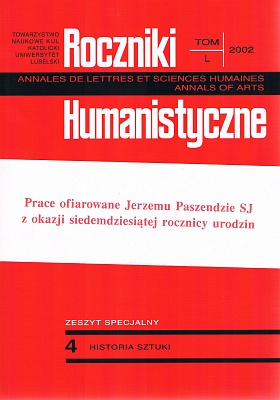Theatrum Canonizationis. Of Blessed Jan of Kęty, Rome, 16 July 1767
Abstract
Canonization ceremonies taking place in Rome after the Council of Trent were given a rich visual setting. The course of the ceremonies was quite diversified. Prayers and official pronouncements were accompanied by singing, music, sounding bells in all the churches in the city, as well as by street processions, fireworks and firing cannons. All this ceremony was given the name of theatrum canonizationis.
It was usually the main architect of St Paul Basilica who was charged with preparing the visual aspect of a canonization ceremony. He engaged groups of artists and craftsmen who were competent in various areas, as the decoration consisted of sculptures, paintings, engravings, tapestries, or even complicated machines that made it possible to produce special effects. In this way a multidimensional spectacle was created that served evoking in the spectators a suggestive impression of being part of a heavenly mystery. The message of the art was ancillary to propaganda of faith. The theory of the mystagogic mission of art, that was worked out in the Middle Ages, attained perfection here.
The structure and course of the baroque theatrum canonizationis can be seen on the example of an account of the course of canonization of St Jan of Kęty that took place in Rome on 16 July 1767. The Płock Cathedral Canon Rev. Józef Alojzy Putanowicz witnessed the ceremony and made a detailed and reliable account of it. This text will serve as the basic analysis source here.
Jan of Kęty was canonized together with five other saints. Putanowicz describes in detail the decoration of the whole basilica. The picture of the six new saints entering the glory of Heaven and the coats of arms were hanged on the façade. The flag with the picture of St Jan of Kęty that was carried in the procession was an important element of the ceremony. It is still kept in St Florian Church in Cracow. Other visual elements of the decoration that drew one's attention were the three medallions presenting miracles worked by the new saint, as well as devotional articles designed for the use of the faithful, as e.g. holy medals. The account also describes other elements of the decoration, like candles and lanterns, or the papal throne that was exceptionally well decorated.
A festivity celebrating the first anniversary of the canonization prepared in Cracow did not materialize. It was held only in 1775, the Year of the Great Jubilee.
Copyright (c) 2002 Roczniki Humanistyczne

This work is licensed under a Creative Commons Attribution-NonCommercial-NoDerivatives 4.0 International License.





